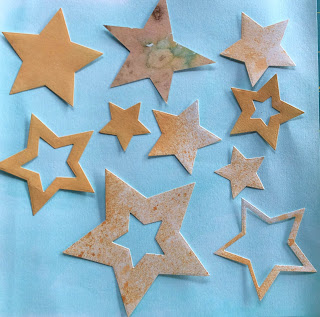Fig.1: Composite sheet
I made a composite sheet as requested in Chapter 11 - sorry it wasn't attached to the relevant blog post but I needed to finalise Chapter 12 in order to complete it. This shows two photographs used as inspiration - the Moroccan tiles from the British Museum and the painted tiles from the town centre showing growth and disintegration. I added a paper design, some stitched stars showing threads used throughout the module, a small selection of fabrics used, including three of the silks used in the final piece. The stitched samples are a padded star covered in seeding stitches, a small star with french knot embellished slips, a star covered with random needlelace stitches and one covered in cutwork holes.
Time and expenditure
The vast majority of the materials used throughout this module have been taken from my existing stocks but the list below identifies specific items purchased.
Chapter 1: Sketchbook £4.50 9.5 hours
Chapter 2: 8 hours
Chapter 3: 14 hours
Chapter 4: Paper £3.00 12.5 hours
Chapter 5: Fabric £8.00 3 hours
Chapter 6: 8 hours
Chapter 7: Thread £3.00 20 hours
Chapter 8: 16 hours
Chapter 9: 10 hours
Chapter 10: 6 hours
Chapter 11: 20 hours
Chapter 12: Silk fabric £8.00 22 hours
Chapter 13: 3 hours
Total: £26.50 152 hours
Health and safety:
- Take normal levels of care whilst using electrical equipment i.e. don't leave electrical cables trailing across the floor or work space.
- Cover all surfaces with plastic sheeting as well as newspaper when using Brusho inks and other paints to protect your work surface.
- Use a cutting mat and non-slip ruler when using a craft knife to cut papers. Replace the blade regularly to ensure a clean cut and always replace the cap when not in use.
- Work in a well-ventilated space with water close at hand when using candles or matches.
- Work on a heat resistant surface when using heat tools.
- Use the correct heat for the fabric when using an iron, and keep fingers out of the way - especially when using steam.
- When bonding fabrics ensure that baking parchment is used beneath and on top of the fabrics being bonded to prevent damage to your iron.
- Take care when using sharp pointed scissors to slash fabric to ensure they don't also slash your fingers.
- Use a darning foot and embroidery hoop when doing free machine embroidery to protect your fingers.
- Always, always keep pins, needles and other sharp items away from pets (and young children if you have them). Cats are curious, playful and very precious!
As I live alone practically my entire house has evolved into my 'studio' so fabric and machine thread is stored together with my sewing machine in one bedroom. Art materials and electrical equipment are stored on fitted shelves around my workbench in the garage, which also has a sink and houses the ironing board (I don't own a car). My hand embroidery threads, embroidery fabric, beads etc for hand stitching are stored on shelves in my study (which also houses my computer and printer).
- Threads are sorted by type and colour, wound on cards and stored in labelled, transparent plastic boxes.
- Fabric is sorted by type and stored in labelled transparent plastic boxes.
- Electrical equipment is also stored in a plastic box to ensure it is kept dry and away from harm or prying paws.
- Papers are stored flat in a box.
- Art materials are stored in labelled drawers and plastic boxes by type e.g. pens; pencils; paints; inks; fabric paints; stamps; stencils; punches etc.
- I made a double pinboard from fabric covered foamboard with fabric hinges and a tie so work in progress and inspirational pieces can be stored safely between work sessions.




























